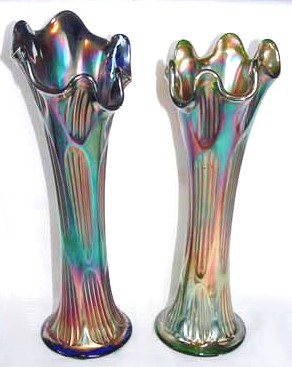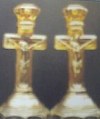Fenton Vases - Part 1
FENTON VASES - Part 1
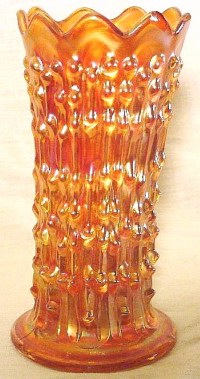 |
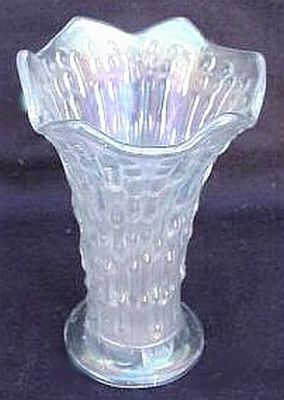 |
Marigold APRIL SHOWERS Squatty Vase
6 3/4 inches tall
|
White APRIL SHOWERS
7 3/8 inches tall, 3 1/2 inch base
and a 4 3/4 inch opening
|
APRIL SHOWERS: (squatty): is frequently seen in a variety of colors, but seldom is found in this stubby size, ( 7” or less) which offers the true extent of those “dripping showers”. As the vase was swung into various lengths, so the shower effect was more scattered across the surface of the vase. Locating one such stubby version, is a rare opportunity, we believe. In our 30 years of collecting, perhaps this is one of fewer than a half dozen seen. This short size is reported in amethyst, blue, green, marigold and white.
APRIL SHOWERS (standard): in white is not often found. To locate a piece in frosty Fenton white, which also has multi-color iridescence is to have found a treasure! Many times, the Fenton white is more clear in nature, but having good color, or it will be frosty, without much colorful iridescence. Generally speaking, these swung vases can extend from 8” to 15” in height. Amethyst, amethyst opal, blue, green, marigold, red, vaseline and vaseline with marigold overlay are additional colors to look for.
DIAMOND & RIB: (Fenton's pattern #504): Vases are standards in the Fenton line, with this design found in white, blue, green, amethyst, marigold, and in varying lengths up to about 11-12”. The Standard vases have 3, 3 ¼ or 3 ½” base sizes. There are Jardinière types in green and marigold. These are “mold shape”, having straight sides, and Funeral sizes having a 5 ¼” base. A couple of small spittoon-shaped whimsies, both in green, are in private collections. Diamond and Rib was produced (at least) from 1911-1913.

Celeste Fenton PANELS - 11 inches tall
Fenton PANELS: is a very simply designed, well executed design having six panels, tapering down to a
3 ½” base. It is quite attractive in the Celeste Blue. A deeper blue towards cobalt is to be found. An occasional ice green presents itself, but marigold is the usual color for this pattern. 11-12” is the usual height.
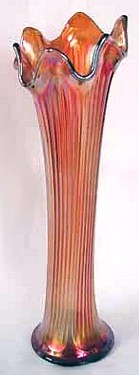 |
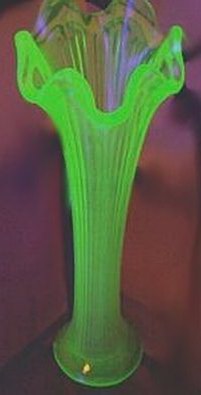 |
Fenton FINE RIB in Red
9 inches tall
|
FINE RIB in Vaseline
11 1/2 inches tall
|
FINE RIB: (Fenton's pattern #1126): First appeared in Butler Bros. ads in 1918, extending into 1927, to include lovely examples in Red, to supply the public's fascination with ever more iridized carnival glass. Proven to be such a great seller, that it can be obtained in scarce vaseline. This “long-lived” pattern can be found in amethyst, amethyst opal, green, blue, marigold, celeste, lime, lavender, moonstone, sapphire, vaseline opal, which is rare, aqua, and aqua opal, along with amber. Of all the Fenton vases, this one is probably more prevalent than any other pattern.
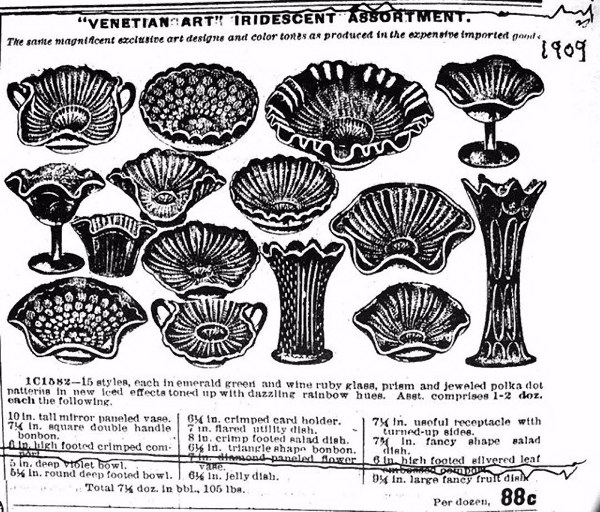 |
|
Oct. 1909 Butler Bros. Ad showing Fenton Assortment
|
|
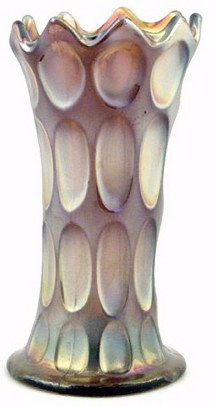 |
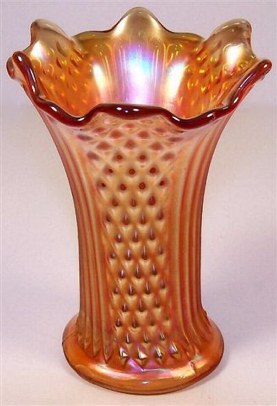 |
Amethyst LONG THUMBPRINT
7 inches tall x 3 1/2 inch base
|
DIAMOND POINT COLUMNS
6.75 inches tall
|
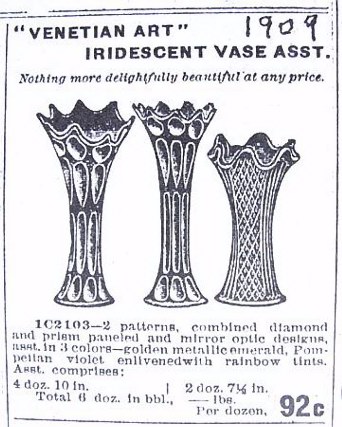 |
|
Fenton Vases October 1909
|
|
DIAMOND POINT COLUMNS: Heights range from 7-12”. All bases are 3 ½”. Squatty versions are pretty scarce and can be as short as 5”. This vase is very likely the first iridized vase from Fenton. It is shown in a Sept. 1908 Butler Brothers Wholesale Catalog ad, included in their “Golden Sunset Assortment” of products. At some point in time, these vases were reissued by Fenton in amethyst; perhaps other colors, as well. The older vases are known in amethyst, green, lime green with marigold overspray and vaseline with marigold overspray. The squatty vases are seen only in marigold.
LONG THUMBPRINT: is another vase of longevity in Fenton production. Just as Diamond Point Columns, Long Thumbprint dates back to 1909. Said by some to be a “ho-hum” pattern, often found in flea markets, Jack-in-the-pulpit versions are rare, none-the-less! Size ranges are from about 7”-12”. Some of the shorter vases will command a bit more money. JIP types have been found in amethyst and marigold. The straighter, flared vases are known in amethyst, green (a common color), marigold, and olive green.
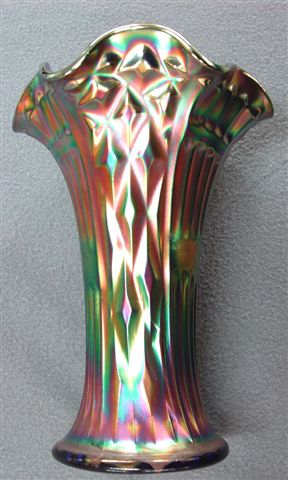 |
 |
Blue #916 Fenton Vase- 8 in. squatty vase
|
Swung out to 17 in.- Blue
|
Sometimes called SPEARHEAD & RIBS or SPEARHEAD & DIAMONDS
|
|
SPEARHEAD & RIB or Diamonds: (Fenton’s pattern #916): is scarce in the squatty 8” sizes. Unswung shorter ones display the patterning adequately, but when swung to their customary 15"-17" sizes and then crimped at the top as well, the pattern is lost. Perhaps these were primarily designed and created for utilitarian purposes, to be used as "funeral-type" vases. For those collectors who enjoy the artistry of the mold makers patterns, this one leaves a lot to be desired.
The short vase shown here sold at a Reichel sale in Jan. 2005 for $65. (with a rim chip). Some of the taller blue ones will bring $100, marigold-about $75. Some years ago, an amethyst 17" sold for $50. A green example might bring the most money, because Fenton green is fairly scarce in most of their patterns.
A Note to Beginning Collectors
|
|
Thirty years of experience dictates that it is much more satisfying and wise to study and learn about as much carnival glass as you possibly can, before “buying it by the dozen, or by the pound!” (smile). Attend a few large carnival glass auctions, read all the books you can find,
study our carnival glass 101 site! It is a book of experience and research in its own right!
This effort will afford the greatest possible long-term pleasure in your purchases. When depending upon “advice and suggestions” from “others” you will be led to a dependence upon the investment aspect of collecting, paying much too much for only the “touted, high-end pieces of glass”; whatever is being “promoted” at the moment! There should be a greater interest in “collecting” for the sheer beauty of the patterns and wide variety of colors available. If you only buy what someone else suggests is a “good investment”, you are not really buying what you like!
After all, this is a business world, and keeping your own counsel is sound advice.
|
Dean & Diane Fry - 4/05


*INSIGHT*
In John 1:10, the Greek language contains a subtle shade of meaning in the phrase, “He came to His own, and His own did not receive Him.” A more literal rendering would read, “He came `to His own things'.” This refers to the created world that Christ spoke into existence by His words. “His own did not receive Him” refers to the Israelites, who rejected Him. How amazing for Jesus to have been in the world He created and to live with His covenant people, yet be rejected by them. Jesus will not force His fellowship on anyone. But those who receive Him by faith become children of God.

Should you care to contact the Frys, their email address is:
Search Our Sites
back to Carnival Glass 101
Our other sites you may enjoy:
Everything you EVER wanted to know about Indiana Glass
Great Reference for Newer Carnival Glass.
Complete Glassware Catalogs Available to Download
Questions? Comments? Suggestions? Broken Links? Corrections?
Your Friendly Webmaster is here to help!
